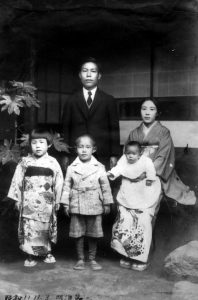My Life — Interview with Hiroshi Morishita (1930-), A-bomb survivor and teacher, Part 2: Childhood
Jun. 20, 2024
Good memories of Hiroshima from its time as military city
Mr. Morishita was born in Osakikamijima-cho in Hiroshima Prefecture as the oldest son of his father, Hisayoshi, and mother, Yoshiko.
I became a teacher due to the strong influence of my father. He had been a teacher at an elementary school in Imabari City in Ehime Prefecture. To carry on the lineage of a distantly related, childless family on Osakikamijima Island, my mother was adopted into the family as their daughter. By marrying her, my father married into that family. He apparently went back and forth between the island and Imabari. He first taught science but also liked history. While studying historical documents, he became more and more interested in calligraphy. Later, he would give calligraphy lessons to many children at our home.
My father was not strict but was passionate about my education. I recall my mother as being kind and beautiful. She was known throughout the island as a ‘beauty.’ Since my father was assigned to work at an elementary school in the area of Oshiba (now part of Hiroshima’s Nishi Ward), we all moved to Hiroshima when I was about four years old.
His family moved to the present-day area of Nishihakushima-cho, in the city’s Naka Ward, a district symbolic of “Hiroshima as a military city” because it was near Motomachi, where facilities of the former Japanese Imperial Army were concentrated.
In the fall of last year, I went on a tour of the grounds of the former facilities of the “Shichotai” (the former Imperial Army’s transportation unit known as the Chugoku District transport soldier recruitment unit). As you know, remnants of the facilities were unearthed near the construction site of the new soccer stadium. It was hard to walk around that area, but it was so nostalgic because my home had been located right near there.
My family was made up of six people, including myself, my parents, two younger sisters, and my grandmother, who had made the move with us. I entered Hakushima Elementary School in 1937, the year the Sino-Japanese war broke out. The soldiers used to pass by in front of our house almost every day. I remember the soldiers running while holding on to something like telephone wire in their hands. It was probably training for connecting telephone lines on the battlefield. I often saw dung of military horses on the streets in my neighborhood.
Soldiers had been assembled in Hiroshima from all over Japan. While they waited to depart from Ujina Port in Hiroshima’s Minami Ward before going off to war, ordinary people in Hiroshima offered to let them stay in their homes. Soldiers also came to my house. I had an inferior complex about the fact that no one in my family was serving in the military, so I was a happy that my family could offer them meals and baths.
Before the Pacific theater of World War II had begun, we still enjoyed living in freedom. I once went to an Army hospital in Hiroshima’s Motomachi area with my friend for fun, and we were given bowls of barley rice. On the Western Drill Ground, located on the present-day site of the former Hiroshima Municipal Baseball Stadium in the city’s Naka Ward, a festival that had brought in a circus and motorcycle races was being held. Those were good memories for me.
(Originally published on June 20, 2024)








